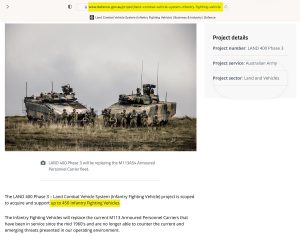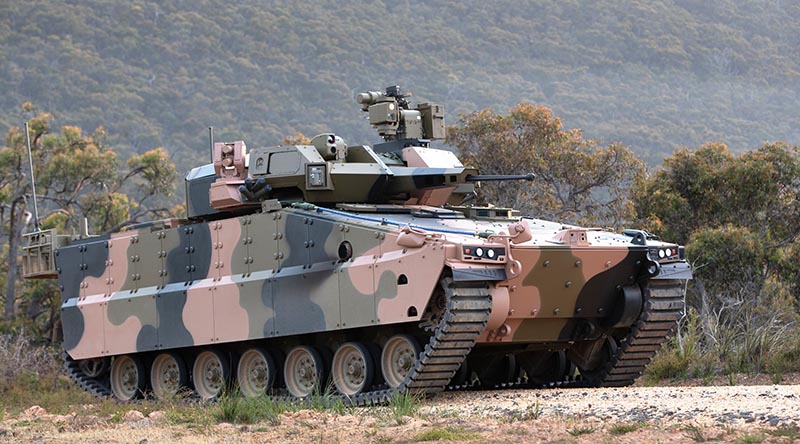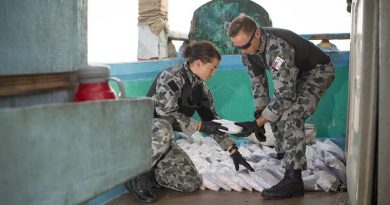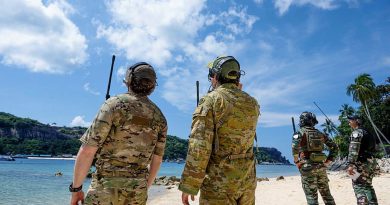LAND400: Gold-medal govt PR/BS = big loss for Army
Share the post "LAND400: Gold-medal govt PR/BS = big loss for Army"

The Albanese Government announced today that it had decided which company would supply the Australian Army’s new infantry fighting vehicle.
FILE PHOTO: Hanwha Redback, chosen as The Australian Army’s new infantry fighting vehicle. Image supplied.
And the winner is Korean-parented Hanwha Defense Australia – sort of.
While the Albanese Government announced Hanwha as the preferred tenderer to deliver the new IFVs – they also announced that the fleet, which was originally planned to be 450 vehicles, would be cut to just 129.
Today’s announcement was made by Minister for Defence Industry Pat Conroy – though one would have thought the Australian Army’s biggest ever acquisition announcement might be worthy of being delivered by Deputy Prime Minister and Minister for Defence Richard Marles. Apparently, he recused himself because the Hanwha factory where these vehicles will be built is in his electorate.
Nevertheless, Pat Conroy delivered the news, dripping with gold-class political spin.
Without once mentioning, at all anywhere in his delivery, that his government had unilaterally reduced the fleet size by nearly 75 per cent, or that today’s announcement is more than a year late, he did manage to brag that “the government is accelerating this acquisition so that the first vehicle will be delivered in early 2027, two years earlier than the former government had planned”.
 Mr Conroy also said the acquisition of these 129 infantry fighting vehicles was part of the current government’s drive to modernise the Australian Army [ahem – doesn’t LAND400 Ph3 predate the current government by many, many years] to ensure it could respond to the most demanding land challenges in our region – though Defence itself still maintains on its web site (see screen-shot at right, taken today at 2:14pm) that up to 450 vehicles was its preference to get the job done.
Mr Conroy also said the acquisition of these 129 infantry fighting vehicles was part of the current government’s drive to modernise the Australian Army [ahem – doesn’t LAND400 Ph3 predate the current government by many, many years] to ensure it could respond to the most demanding land challenges in our region – though Defence itself still maintains on its web site (see screen-shot at right, taken today at 2:14pm) that up to 450 vehicles was its preference to get the job done.
Mr Conroy also claimed that “the government has also decided that the new vehicles will be built in Australia at Hanwha’s facilities in the Geelong region” [ignoring the fact that building the vehicles in Australia was a key condition of the project from day one – with the Request for Tender released to industry on 24 August 2018].
“The project will deliver Hanwha’s state-of-the-art Redback infantry fighting vehicles that will provide high-level protection and mobility for soldiers” [except of course for those soldier who would have otherwise travelled and fought in the 321 vehicles cancelled by this government].
Mr Conroy said the new vehicles would replace Defence’s M113 armoured personnel carriers, [840 of which were acquired in 1964, with more that 400 still in service].
“Project LAND 400 Phase 3 will have a value of between $5billion to $7billion, making it one of the largest capability acquisition projects in the history of the Army,” Mr Conroy said.
“With its latest generation armour, cannon and missiles, the Redback vehicle will provide the protection, mobility and firepower required to transport and protect soldiers in close combat, giving them the highest chance of achieving their mission and returning home safely.
“Significantly, the infantry fighting vehicles will be delivered at around the same time as the new HIMARS missile systems and army landing craft – reflecting the Defence Strategic Review’s call for Army to be transformed for littoral manoeuvre operations from Australia.
“This decision demonstrates how* the Albanese Government is providing the Australian Defence Force with the capabilities it needs to defend Australia and protect our national security.” [*how? – by ignoring the ADF’s own assessment that 450 vehicles were required]
Defence will now enter negotiations with the preferred tenderer to finalise the ultimate contract cost and return to government for final approval before the contract is finalised.
While this project includes a myriad of fixed-cost items, such as garaging and yarding facilities (much of which would be the same regardless of the number of vehicles acquired) – and also includes support, maintenance and spare parts consideration – nonetheless, a project cost of $5 to 7billion equates to $38.76 to $54.26 million dollars per each vehicle!!!
.
.
.
.
Another comment from resident crankyman Sir Jeffrey Armiger – a retired Public Servant with a pet hate for BE (bovine excrement).
Follow Sir Jeffrey on Facebook here
or view his previous diatribes here.
.
.

.
.
Share the post "LAND400: Gold-medal govt PR/BS = big loss for Army"




![Australia, the United Kingdom, and the United States have successfully demonstrated the integration of advanced autonomy and artificial intelligence (AI) to test the resilience of autonomous assets in a contested environment. Conducted in South Australia in late 2023, the Trusted Operation of Robotic Vehicles in a Contested Environment (TORVICE) trial combined Australian, UK and US innovation and technology to test leading-edge AI in uncrewed robotic vehicles. TORVICE tested the ability of autonomous vehicles to complete their missions and preserve network connectivity in a contested environment. In December 2023, AUKUS Defence ministers announced that resilient and autonomous artificial intelligence technologies would be integrated into national programs in 2024. The TORVICE trial takes us a step closer to adopting these technologies in the land domain. The trial comprised UK and US robotic ground vehicles to represent autonomous multi-domain launchers and uncrewed ground vehicles, tasked to conduct long-range precision fires and other associated missions. The vehicles carried no weapons during the trial. Australian scientists subjected the vehicles to attacks from electronic warfare, electro optical laser, and position, navigation and timing systems to test resilience. Guy Powell, Principal Adviser, Land Autonomy, UK Defence Science and Technology Laboratory, said networked autonomy would be critical to future warfighting. “Robotic and autonomous systems have the potential to transform the battlefield providing a force multiplier while reducing risk to warfighters,” he said. “TORVICE allows us to understand robotic autonomous systems' operation in a contested environment and increase resilience of these systems. Working across three nations will accelerate development of robust capable systems.” Shane Canney, Chief Land and Integrated Force, Defence Science and Technology Group,saidinteroperability with AUKUS partners on land, at sea, in the air and in cyber space would support the ADF to maintain its strategic military edge. “Understanding how robotic vehicles react in contested environments accelerates our collective know-how and helps improve the system to overcome such attacks,” Dr Canney said. “Transitioning trusted robotic capabilities into the hands of our warfighters safely and ethically is a priority.” Kimberly Sablon, Principal Director for Trusted Artificial Intelligence and Autonomy, US Department of Defense, said TORVICE built uponthe first AUKUS artificial intelligence and autonomy trial held in the UK. “The TORVICE project builds upon the work the AUKUS partners demonstrated in Salisbury in April [2023],” Dr Sablon said. “During this exercise, we performed rigorous red teaming of our autonomous and AI systems to assess and mitigate vulnerabilities and to improve their resilience in contested and complex environments.” Through AUKUS, Australia, the UK, and the US are collaborating to accelerate collective understanding of AI and autonomy technologies, and how to rapidly field robust, trustworthy AI and autonomy in complex operations. Australia, the UK and the US continue to uphold the values of safe and responsible use of AI.](https://www.contactairlandandsea.com/wp-content/uploads/2024/02/20240206adf8694556_02.png.iifBqeHeMRUtk71jYBMA.wgYb_wPkjw-390x205.jpg)

Not sure about the rubberised tracks, though. How do you fix those when they get damaged in the field? And, how do you get a 42 ton vehicle across a creek?
It’s not 42 ton, that’s the other losing bid
>>>A project cost of $5 to 7 billion equates to $38.76 to $54.26 million dollars per each vehicle!!!
Really! How did you work that out?
If one assumes that the sustainment cost is about the same as the procurement cost over the lifetime of the asset, that gives $19.38 to $27.13 million procurement cost per vehicle. If they remain operational for 30 years that means an ammortized procurement cost of $646 – $904K per vehicle per year i.e. about the cost of a house (today, and not in 30 years from now).
However, a large portion that money is not leaving Australia. Some of it remains in the production facility required to build them. Some of it remains in the license for the intellectual property required to build them. Some of it remains in the profits of the companies that supply the materials and components needed to build them. Some of it remains in the wages paid to the Australian’s who will build them. And, part of it is returned to the national treasury in the form of personal income and other taxes. Some of it is gobbled up by inflation. Some of it is gobbled up by movements in the foreign exchange rate for those components we are unable to manufacture in Australia.
And … if we need more of them, then we can build them.
How much is a soldier worth? More or less than a house?
How much does a soldier pay in income tax over a period of 30 years? More or less than a house?
How many soldiers get to come home if they ride in an IFV, rather than on the back of a Toyota 4WD?
Asserting $38.76 to $54.26 million dollars per each vehicle reflects a lack of understanding of the real cost of military procurement and wartime operations. Apples are not pears, and simple attempts at cost comparisons, like this one, are misleading.
This Country has a very poor track record of defence-based decisions. If you lock back to WW2 we sent the bulk of our ground forces to the middle east, in spite of the threat to our Nth. Now we are sending more and more equipment at a massive cost, given that the equipment has to be recommissioned and transported to the Ukraine. We have personnel on the ground and an aircraft over there as well. All this so the bloody P.M can ‘big note’ himself get his photo taken with Zelinsky and he can blame the war over there for our cost of living. What we have now is WW 2.2 we get involved in a war in Europe while the wolves are knocking on our front door.
A book could be written about our ‘dumb’ defence decision and acquisitions, selling the RAN’s Skyhawks to NZ, then having to bring then back under contract. Buying helicopters that unsuitable for purpose on two separate occasions. Costing millions because one had a airframe from the 50’s, that was imposable to fly when fitted with weapons. Another unsuitable for SAR tasking, resulting in the Navies aviation SAR role being outsourced. Buying second hand ships that where decommissioned by the original owner due to on-going issues with leakage with the loading doors. Closing down the ComCen at Jervis Bay and then wondering why there are issues with radio coms, as the area has been a known ‘black spot’ since you guessed it WW2. This list is just with the RAN, I bet retired member of the other two services could substantially add to this list.
One only has to look at the `battle field’ in Ukraine where two big armies are head to head to realise we are just a bit player and after we fire our couple of missiles and poke our tongues out we are done. We are at best a local area militarised police force that can contribute a small force to any major player in our region.
Max, if all deployed together we could lift maybe 2 battalions and support. That would scare the Samoans or Fijians at best.
Why only a 30MM Gun when all the other European countries are moving towards 40MM Guns on their IFV and the US is now investigating a 50MM (XM 913) Gun for its new IFV. Are we being left behind again? Even the South Koreans have 40MM Guns on their N21 IFV – so why did we downsize – possibly to make it have the equivalent of the Boxer perhaps??
30mm x 173mm is an in service ammunition with a multitude of NATO countries, the US and UK using it. The cannon can be easily upgraded to a 40mm by changing out a few parts.
A barrel change allows upgrading to 50mm
The Labor party hates the military. Remember the unions embargoes on filling ship for our soldiers during WWII and having to be replaces by soldiers. As a 1980s soldier, I remember going from firing and exercising regularly to haven’t fired my tank cannon in 18 months after Bob Hawke got in. All we did was dress parades and cleaning shithouses for a living.
Only surpassed by the acquisition costs for the new Hercules aircraft for the RAAF, at an apparent total cost of $500million each.